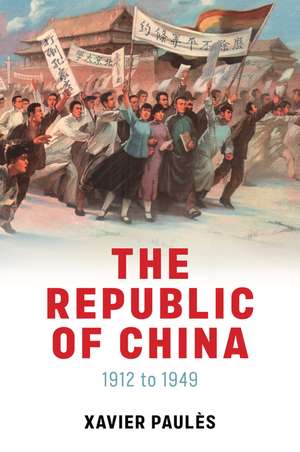The Republic of China – 1912 to 1949
Autor X Paulèsen Limba Engleză Hardback – 23 noi 2023
Preț: 170.98 lei
Nou
Puncte Express: 256
Preț estimativ în valută:
32.72€ • 33.95$ • 27.35£
32.72€ • 33.95$ • 27.35£
Carte disponibilă
Livrare economică 24 februarie-10 martie
Livrare express 07-13 februarie pentru 39.70 lei
Preluare comenzi: 021 569.72.76
Specificații
ISBN-13: 9781509552573
ISBN-10: 150955257X
Pagini: 368
Dimensiuni: 160 x 236 x 35 mm
Greutate: 0.68 kg
Ediția:1
Editura: Polity Press
Locul publicării:Chichester, United Kingdom
ISBN-10: 150955257X
Pagini: 368
Dimensiuni: 160 x 236 x 35 mm
Greutate: 0.68 kg
Ediția:1
Editura: Polity Press
Locul publicării:Chichester, United Kingdom
Notă biografică
Xavier Paulès is Associate Professor in History at EHESS, Paris.
Cuprins
Acknowledgements List of Illustrations and Maps Introduction Chapter 1: The 1911 Revolution The flashpoint in Wuhan The last dynasty's unorthodox downfall 1912, the year of many possibilities The years under Yuan Shikai (1913-1916) The international context and the influence of the war in Europe The fall of Yuan Shikai Chapter 2: Cliques And Warlords (1916-1928) The rivalry amongst North China's major cliques for control of the government Who were the warlords? The implausible identikit portrait The driving forces behind junfa power Conflicts, alliances and viscosity Was national unity in jeopardy? The diplomatic context, May Fourth Movement (1919) and the rise of nationalism Two decades of spectacular diplomatic recovery for China (1906-1926) Disappointed expectations from the Versailles negotiations A movement without precedent The rise of the Guomindang (1917-1926) and the Canton decade 925: the death of Sun Yat-sen and its aftermath, the May Thirtieth Movement The Northern Expedition Phase 1: the defeat of Wu Peifu and Sun Chuanfang Phase 2: the time of divisions Phase 3: Zhang Zuolin's defeat Chapter 3: The Nanking Decade (1928-1937) 1928-1932: Troublesome former allies The period of stabilisation: 1932-1935 The Guomindang's achievement The looming Japanese threat Warlords on the wane The successful marginalization of the Chinese Communist Party The successful marginalisation of the Chinese Communist Party The run up to the Sino-Japanese war: 1935-1937 Chapter 4: The War Against Japan (1937-1945) The war of movement: 1937-1939 Why did Chiang Kai-shek choose confrontation? Japan's first victories The Second United Front and Soviet aid 938, the difficult conquest of the Middle Yangtze River basin 1939, settling in for a long war The war of position (1940-1944) Stabilisation of the front Population movements China and the Allies 1940: the beginning of the Guomindang state's disintegration The CCP, a new force Mao Zedong and Chiang Kai-shek, the crossed paths of destiny Occupied China and the collaborating governments 1944-1945: return to the war of movement From the Ichig offensive to the surrender The war's outcome Chapter 5: Civil War (1945-1949) A very favourable situation for the Guomindang The political and symbolic dividends of victory The economic rebound in the immediate post-war period Immediately post-war: 1945-1946 The role of the USSR and the USA Locking of horns for the first time The Guomindang's post-war failure The military era: 1946-1949 Sclerosis of the Guomindang The issue of corruption Lack of renewal within the Guomindang The impossible democratic transformation The CCP's policy A third force gone missing The withdrawal to Taiwan, a victory for the Guomindang? Chapter 6: Overview of the Chinese Economy China in an international context The financial and monetary system The shortcomings of the financial system Progress and crisis in the monetary system The primary sector The very slow evolution of the agricultural sector Mining: the triumph of coal and emergence of oil The secondary sector Industry and the rise of Chinese capitalism Maintaining cottage industries The service sector Transport Traditional services The effects of the 1937-1945 war and the civil war Relocation and state control of the economy The origins of Communist China's planned economy? Chapter 7: Building the State Political culture Inventing a political culture Continuities with the New Policies period Continuity with an older political order The Guomindang and the party-state model post 1928 Sun Yat-sen, a guiding light Institutional structure Cliques and clique struggles The endless return of revolution The question of fascism The extension of the State's scope, a fundamental trend The question of the relationship between the State and local elites A plurality of State-building trajectories Chapter 8: Changes in Society The Population Demographic Data Migrations Social groups The proletariat The urban middle classes The recomposition of elites Highly resilient intermediary bodies Living standards and lifestyles The issue of the impoverishment of Chinese peasants Did the Guomindang lose interest in the countryside? Endemic insecurity in the countryside 'Problems' in Chinese society New leisure activities Can we call it westernisation? Women Chapter 9: Cultural Renewal The dissemination of ideas The development of primary and secondary education Higher education The media Passing influences New interest in the non-Western world The May Fourth Movement 1919 and that of the new culture (xin wenhua yundong ) Chinese Culture's Western Crisis A reinvented language The wenti The competition of 'isms' Religious revivals China's cultural influence . The undiminished prestige of classical culture China as a conduit for knowledge from the West Transmission of popular culture Conclusion And Epitaph Timeline Appendixes Sun Yat-sen's Last Will (yizhu ) Comparison of China's population with that of other major countries Comparison of the length of China's rail network with that of other countries (in kilometres) The Song family simplified family tree Maps Bibliography Notes Index
